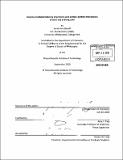Enzyme-mediated labeling of proteins and protein-protein interactions in vitro and in living cells
Author(s)
Slavoff, Sarah Ann
DownloadFull printable version (24.36Mb)
Other Contributors
Massachusetts Institute of Technology. Dept. of Chemistry.
Advisor
Alice Y. Ting.
Terms of use
Metadata
Show full item recordAbstract
The E. coli biotin ligase enzyme, BirA, has been previously used by the Ting research group for site-specific labeling of peptide-tagged cell surface proteins. We sought to expand the utility of biotin ligase-mediated labeling to functional group handles, including azides and alkynes, for bio-orthogonal chemistry. Since the BirA and its point mutants were unable to ligate these probes to an acceptor peptide, we screened biotin ligases from multiple species to identify more permissive enzymes. We determined that the Pyrococcus horikoshii biotin ligase utilizes an azide-bearing biotin analog and that the Saccharomyces cerevisiae biotin ligase can utilize an alkyne-functionalized biotin analog. We subsequently demonstrated that the azidefunctionalized biotin analog can be derivatized with a phosphine probe via the Staudinger ligation. We next turned to the goal of delivering quantum dots to the cytosol of living cells, which in the future may permit intracellular single-molecule imaging. We investigated viral methods of delivery, but found that our protocol caused quantum dots to be trapped in endocytic vesicles. We then validated previous reports that the pore-forming toxin streptolysin 0 be used to deliver quantum dots to the cytosol of living cells. Lipoic acid ligase, or LpIA, has been previously applied to site-specific protein labeling of peptide-tagged proteins using small molecule probes including lipoic acid and coumarin fluorophores. We utilized LpIA and its substrate, the LAP peptide, to create sensors for proteinprotein interactions. If LpIA is fused to one protein and LAP is fused to another, only when the two proteins interact do LpIA and LAP come into proximity, allowing probe ligation onto the peptide to occur as a readout of the interaction. We demonstrate that proximity-dependent coumarin ligation detects protein-protein interactions in living mammalian cells with extremely low background, a signal-to-background ratio of at least 5:1, and sufficiently fast kinetics to label interactions with a half-life of at least 1 minute. The reporter quantitatively responds to subpopulations of interacting proteins, allowing dissociation constants to be measured. Coumarin fluorescence accurately reports the subcellular localization of the interaction under study. Finally, we applied proximity-dependent coumarin ligation to imaging of the interaction of PSD-95 and neuroligin-1, two proteins involved in synaptic maturation, in neurons.
Description
Thesis (Ph. D.)--Massachusetts Institute of Technology, Dept. of Chemistry, 2010. Vita. Cataloged from PDF version of thesis. Includes bibliographical references.
Date issued
2010Department
Massachusetts Institute of Technology. Department of ChemistryPublisher
Massachusetts Institute of Technology
Keywords
Chemistry.